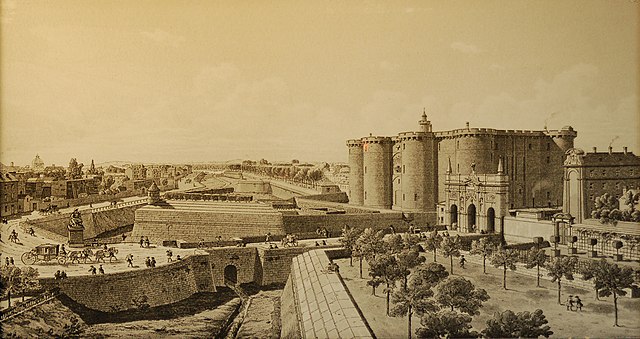The Bastille was a fortress in Paris, known as the Bastille Saint-Antoine. It played an important role in the internal conflicts of France and for most of its history was used as a state prison by the kings of France. It was stormed by a crowd on 14 July 1789, in the French Revolution, becoming an important symbol for the French Republican movement. It was later demolished and replaced by the Place de la Bastille.
East view of the Bastille, drawing c. 1790
Historical reconstruction showing the moat below the walls of Paris (left), the Bastille and the Porte Saint-Antoine (right) in 1420
A 1750 plan of the Bastille's eight medieval towers showing the calottes in the roofs and the infamous cachots within the foundations
A depiction of the Bastille and neighbouring Paris in 1575, showing the new bastions, the new Porte Saint-Antoine, the Arsenal complex and the open countryside beyond the city defences
The Storming of the Bastille occurred in Paris, France, on 14 July 1789, when revolutionary insurgents attempted to storm and seize control of the medieval armoury, fortress and political prison known as the Bastille. After four hours of fighting and 94 deaths the insurgents were able to enter the Bastille. The governor de Launay and several members of the garrison were killed after surrender. The Bastille then represented royal authority in the centre of Paris. The prison contained only seven inmates at the time of its storming and was already scheduled for demolition, but was seen by the revolutionaries as a symbol of the monarchy's abuse of power. Its fall was the flashpoint of the French Revolution.
Storming of The Bastille, Jean-Pierre Houël
Jacques Necker (1732–1804), French minister of finance
The Bastille of Paris before the Revolution
People in the Castle of Bastille, (Musée de la Révolution française).








